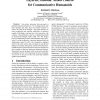Free Online Productivity Tools
i2Speak
i2Symbol
i2OCR
iTex2Img
iWeb2Print
iWeb2Shot
i2Type
iPdf2Split
iPdf2Merge
i2Bopomofo
i2Arabic
i2Style
i2Image
i2PDF
iLatex2Rtf
Sci2ools
CA
1997
IEEE
1997
IEEE
Layered Modular Action Control for Communicative Humanoids
Face-to-face interaction between people is generally effortless and effective. We exchange glances, take turns speaking and make facial and manual gestures to achieve the goals of the dialogue. This paper describes an action composition and selection architecture of characters capable of full-duplex, real-time face-to-face interaction with a human. This architecture is part of a computational model of psychosocial dialogue skills, called †mir, that bridges between multimodal perception and multimodal action generation. To test the architecture, a prototype humanoid has been implemented, named Gandalf, who commands a graphical model of the solar system, and can engage in task-directed dialogue with people using speech, manual and facial gesture. Gandalf has been tested in interaction with users and has been shown capable of fluid turn-taking and multimodal dialogue. The primary focus in this paper will be on the action selection mechanisms and low-level composition of motor commands. ...
CA 1997 | Computer Animation | Face-to-face Interaction | Multimodal Action Generation | Real-time Face-to-face Interaction |
| Added | 05 Aug 2010 |
| Updated | 05 Aug 2010 |
| Type | Conference |
| Year | 1997 |
| Where | CA |
| Authors | Kristinn R. Thórisson |
Comments (0)

